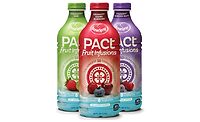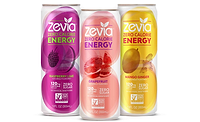There’s an idiom that talks about listening to one’s gut as a way to ward off something that doesn’t feel right. After the brain, the gastrointestinal tract, or gut, is the nervous system’s second-biggest network of closely interconnected neurons that greatly impacts overall health and well-being, experts say. This has resulted in an increase of new and more natural approaches to digestive health with beverage-makers adding fiber, probiotics and “good bacteria” to their new products.
Consumers have become increasingly interested in consuming probiotics as a way to boost their gut health, driving interest in probiotic-containing functional beverages. Sales of refrigerated probiotic functional drinks and juices have increased 31.2 percent since 2016, with probiotic plant-based creamers and milks up 269.7 percent during that same period, according to data from Chicago-based SPINS.
Seventy percent of consumers associate probiotics with healthfulness, leading to widespread acceptance of this good bacteria, says Ilana Orlofsky, marketing manager at Niles, Ill.-based Imbibe.
“In terms of trends related to digestive health beverages, we’ve seen a lot of botanical flavors hit the marketplace, such as elderberry, lavender, lemongrass and turmeric. In terms of innovation, I know of one brand — Aspen Pure Probiotic (from New Age Beverages Corp.) that has developed a proprietary production process that allows for a nine-month shelf life without deterioration to more than 2 billion [colony forming units] (CFUs) of live probiotics,” Orlofsky says. “Shelf-stable probiotics or processing that yields shelf-stable probiotic [ready-to-drinks] (RTDs) will be a game changer, since beverages will not have to compete for the refrigerated aisle (or manage a refrigerated supply chain) like they currently do.”
Although probiotics have benefited from digestive health trends, fiber has been more challenged in the branding of its digestive benefits. “Fiber’s biggest challenge is that it doesn’t seem sexy,” Orlofsky says. “Some beverage brands that are high in fiber (often from fruits and vegetables) include a digestive health claim more prominently than a high fiber claim, but I expect this to change as health-and-wellness proponents implement strategies to alter the perception of fiber.”
Beverage-makers also are becoming more creative, leveraging probiotics in dairy, dairy alternatives, fermented beverages, grain-based products, on-the-go snacks and drinks, and fruit- and vegetable-based products, says Satya Jonnalagadda, director of nutrition at Kerry, Beloit, Wis.
Researchers also are working to link the benefits of prebiotics and probiotics and their impact on gut microbiome with the overall focus on health and well-being, she says.
Prebiotics are a non-digestible nutrient naturally found in foods like asparagus, chicory, garlic, wheat and oats that stimulate bacterial growth or activity in the colon, while probiotics are live organisms, typically bacteria, that provide a health benefit when consumed at certain levels, she explains.
A healthy halo
Experts note that nutrient-rich products that provide added value and a stronger health halo have a greater likelihood of finding success on store shelves.
Pavo, Ga.-based Dreaming Cow Creamery recently launched LUSH, a nutrient-dense, grass-fed and 100 percent pasture-raised yogurt drink that blends fruits with more than 20 billion CFUs of Bifidobacterium-12 probiotics in each 12-ounce bottle, the company says.
Although probiotics typically are used in yogurt-based beverages, they’re also becoming more prevalent in fruit and vegetable juices, which also might contain innate and added fibers that complement the probiotics thereby strengthening the digestive health benefits and messaging, notes Nesha Zalesny, technical sales manager at Fiberstar Inc., River Falls, Wis.
“Since digestive health has been on consumers’ radars for the past few years, this area is set to grow significantly in the years to come,” Zalesny says, citing kefir, cold-pressed or high-pressure processed (HPP) fruit smoothies, as well as alcohol and non-alcohol versions of kombucha as trends contributing to this potential growth.
“Most probiotic beverages enhance gut health and are promoted to help a variety of digestive issues and even candida proliferation,” she continues. “Gut health is closely linked to immune health. There is a plethora of studies about gut microflora and fauna such as differences between normal weight versus an obese individual or a normal individual versus [an] autistic individual. These studies are the catalyst driving probiotic health benefit research, which will support new [and] future claims, target consumer marketing, and customized food product trends.”
Supported by science
Research studies also document the importance of fibers such as chicory root fiber (inulin) on digestive health.
“Studies have shown that 5 grams of chicory root fiber per day not only adds fiber to the diet, but can also help feed normal beneficial probiotic bacteria in the gut,” explains Carol Lowry, senior food scientist at Minneapolis-based Cargill. “As a prebiotic, it enhances the growth of lactobacillus and bifidobacterium species. Consuming 5 grams of chicory root fiber per day stimulates the microflora in the digestive tract, helping to maintain a neutral balance.”
Suitable for functional and flavored waters, powdered beverages, smoothies, and chilled juice applications, Cargill offers its Oliggo-Fiber, a chicory root fiber.
Quality, science-backed ingredients in applications like kombuchas, HPP juices, sparkling beverages, teas and coffees also can help boost sales, says Cleveland-based Ganeden, makers of the patented GRAS probiotic ingredient GanedenBC30.
Ganeden’s Vice President of Scientific Operation’s David Keller notes that although probiotic strains might look alike, efficacy is strain-dependent and claims need to be supported by strain-specific data.
“Beverage manufacturers that formulate with GanedenBC30 can make claims including supports digestive health, supports immune health, enhances protein utilization and survives 10 times more effectively than yogurt cultures,” Keller explains. “In the past, due to survivability issues, probiotics were restrained to the supplement or refrigerated dairy categories. However, GanedenBC30 can survive almost any manufacturing process … and does not need to be combined with a prebiotic to have beneficial effects on the end-user.”
From a formulation standpoint, probiotics are “quite easy” to incorporate into beverages as they have a fairly neutral taste profile, Imbibe’s Vice President of Research and Development Joe Farinella notes.
Yet, because probiotics are sensitive to high temperatures, he advises beverage formulators to add overage to their formulas and to reduce high-temperature exposure as much as possible throughout the pasteurization and packaging processes.
“These challenges are only applicable to probiotics in the ready-to-drink formats,” Farinella says. “Probiotics in a dry format are highly stable, making powder an appealing vehicle to deliver the health benefits of probiotics.”
Neeraj Sharma, senior research development and applications scientist at Kerry, echoes similar sentiments. “Powdered nutritional and isotonic beverages would capture the benefits of both pre- and probiotics as these categories deliver the health benefits demanded by consumers and there is a lesser chance of cultures degrading over time in powdered beverages.
“… Some probiotic cultures can survive UHT temperatures; however, the cleanliness of processing equipment should always be top of mind from a food safety perspective,” she continues. “Similarly, in high-acid beverages, some types of prebiotic fibers will break down into simple carbohydrates over time through hydrolysis. Therefore, the determination of total dietary fiber in a finished product should be evaluated at the end of the shelf life rather than at the beginning.” BI





